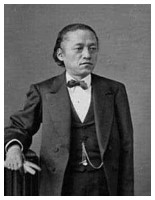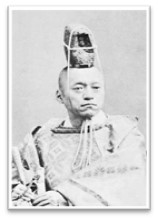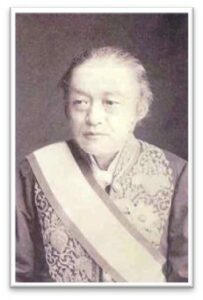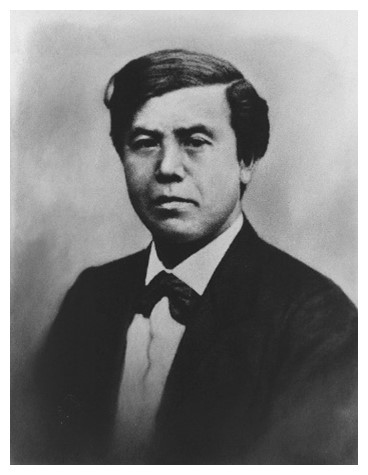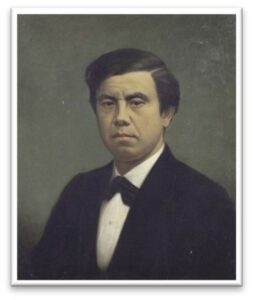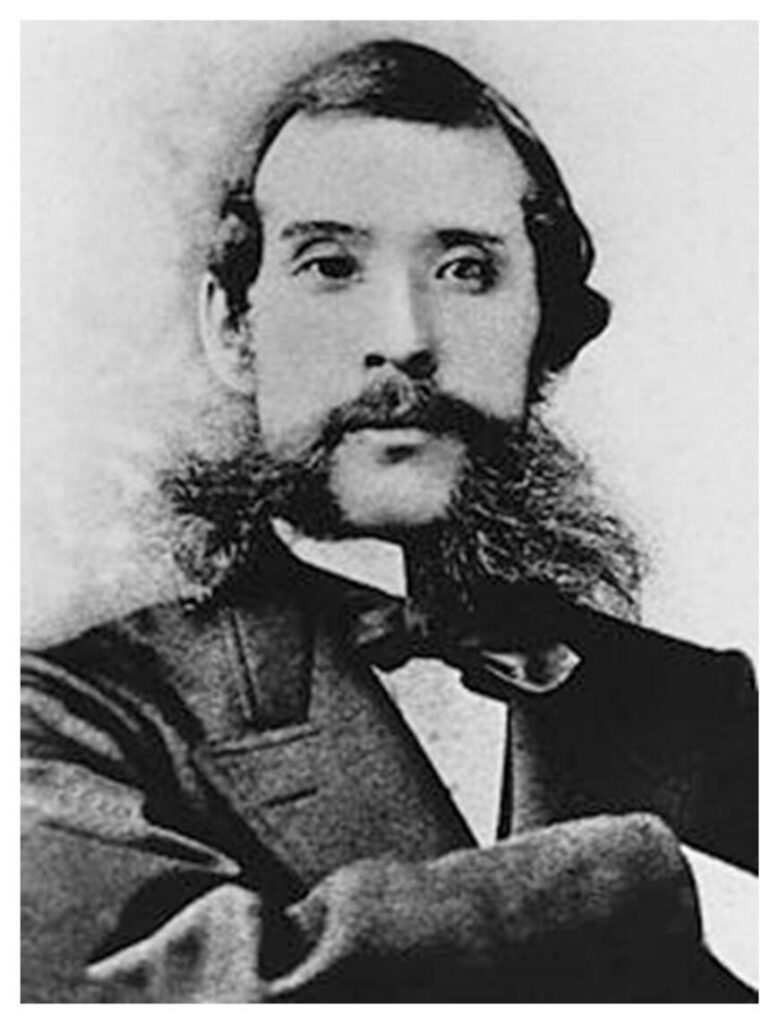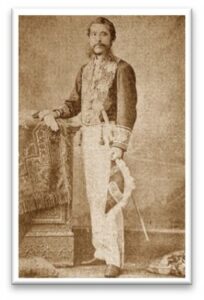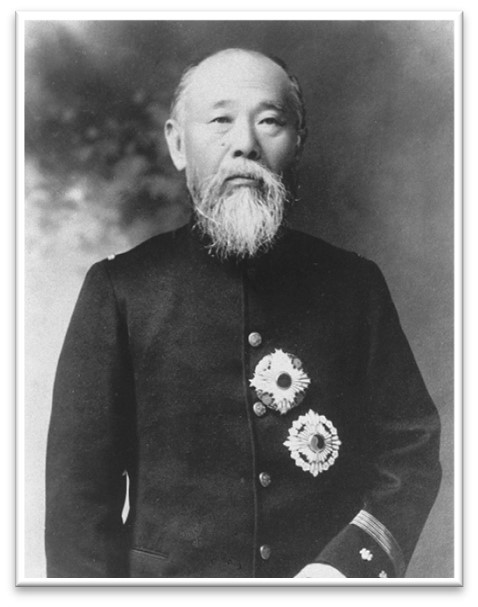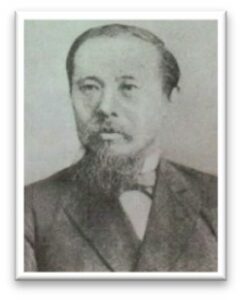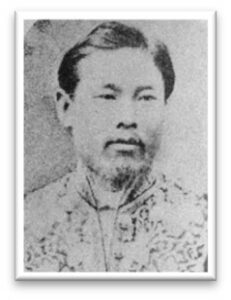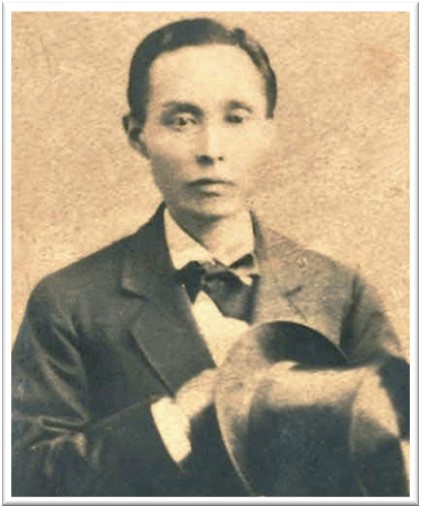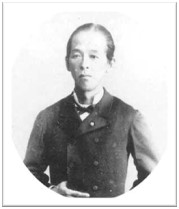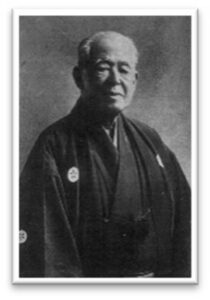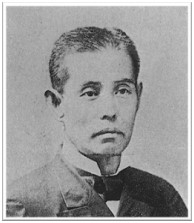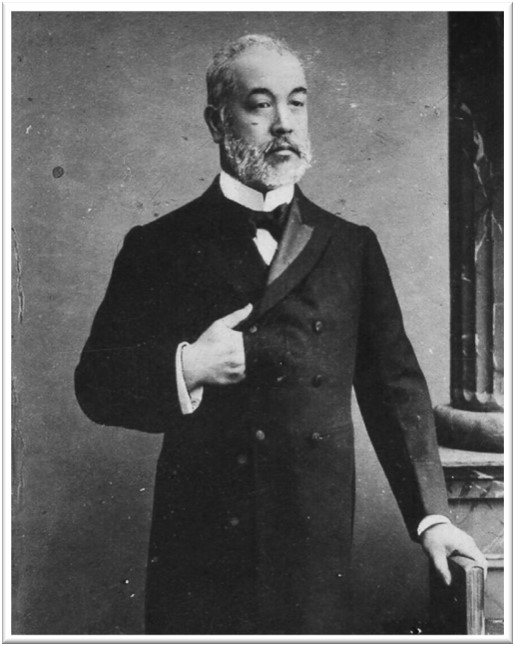Iwakura Mission Members
Iwakura Tomomi
Ambassador Plenipotentiary
Tomomi Iwakura (October 26, 1825 – July 20, 1883) was adopted as the son and heir of the wealthy and powerful Iwakura family. With prowess, he was able to position himself as a member of a small group of conspirators who brought about the Meiji Restoration (1868), thereby ending the reign of the previous shogunate. The new leadership, which leveraged the reputation of the Meiji emperor as a force for modernization, aimed to study Western systems of education, government, economics, and legislation, among other modes of thought. To assist with this goal, Iwakura was selected to lead a delegation of over 50 senior government officials on a visit to numerous Western nations, to be known as the Iwakura Mission. Although the mission was ostensibly dedicated to the work of treaty revision, it also served as a study of modern American and European states, and upheld a form of “soft power” (non-coercive persuasion) for the newly created Meiji government. Upon his return to Japan, Iwakura adapted what he had witnessed during his journey into modernization initiatives, including the creation of the Imperial Constitution and the expansion of the national railway network.
Takayoshi Kido
Vice Ambassador
Takayoshi Kido (August 11, 1833 – May 26, 1877) was a Japanese samurai and politician, who for much of the Meiji Restoration served in a capacity similar to a Prime Minister. He advocated progressive ideas, such as public elections for governmental officials and the establishment of prefectures to overthrow feudal systems of power. Kido participated in the Iwakura Mission as Vice-Ambassador, and was influenced by the education systems he witnessed in America. Upon returning to Japan, he held roles such as Education Minister and Home Minister, and promoted public schools on a nation-wide scale. Kida also urged members of the samurai class to build a career in industry.
Toshimichi Okubo
Vice Ambassador
Toshimichi Okubo (1830–1878) was a soldier, feudal retainer of Satsuma, and politician who was prominent in Japanese politics throughout the Meiji Restoration (1868). In 1871, Ōkubo was appointed Finance Secretary, and in 1872 he joined the Iwakura Mission as Vice Ambassador. During his travels, he was intrigued by the forms of Western governments. Upon his return to Japan, Ōkubo established the Ministry of Home Affairs and appointed himself Secretary of the Interior. In this new position, he advocated for industrial development and land tax reform.
Hirobumi Ito
Vice Ambassador
Unlike the other Vice-Ambassadors on the Iwakura Mission, Hirobumi Ito (16 October 1841 – 26 October 1909) did not play a large part in the Meiji Restoration (1868). Nevertheless, he surrounded himself with the soon-to-be leaders of the new Meiji government, such as Takayoshi Kido, and rose to become an exceptionally powerful politician. In this company, he was highly appointed on the Iwakura Mission. After his return to Japan, Ito obtained the title of Home Minister, thus consolidating his position as the government’s most powerful official. In 1882, he returned to Europe to continue his education in constitutional studies. In 1885, he founded a cabinet-style administration in Japan and was appointed as the country’s first Prime Minister. He also played a key role in ratifying the country’s constitution.
Naoyoshi/Masuka Yamaguchi
Vice Ambassador
Naoyoshi Yamaguchi (June 21, 1839 – June 12, 1894) was a senior government administrator. In 1870 he was promoted to Assistant Minister of the Ministry of Foreign Affairs, a role that earned him an assignment on the Iwakura Mission. As a Vice-Ambassador within the delegation, Yamaguchi was tasked with aiding Iwakura’s efforts to revise Japan’s treaty with the United States. He also brought his son, Shutaro, with him on the journey. While in Britain, Yamaguchi was impressed by the country’s education system and left his son there to study. After returning to Japan, Yamaguchi would achieve the ranks of Associate Judge of the Supreme Court and member of the House of Peers.
Kunitake Kume
Kunitake Kume (August 19, 1839 – February 24, 1931) was brought on the Iwakura Mission as a man of many talents, and as such served many roles. He was the private secretary to Tomomi Iwakura, editor of the delegates’ travelog, and official reporter of the journey. During the two-year long journey, Kume interviewed thousands of locals with help from interpreter Yoshinari Hatakeyama. Using these interviews and his own observations, Kume compiled texts on statistics, geography, and history. His official report to the Japanese government, entitled “Tokumei Zenken Taishi Beio Kairan Jikki” (A True Account of the Ambassador Extraordinary & Plenipotentiary’s Journey of Observation Through the United States of America and Europe) was compiled into five volumes in 1878. While it was an official publication, Kume included many of his personal thoughts that did not necessarily reflect the attitudes of the delegation. Nevertheless, it was well received by both the government and public, and he was promoted to the rank of officer with the Grand Council of the State.
Genichiro Fukuchi
Genichiro Fukuchi (May 13, 1841 – January 4, 1906) was a journalist and statesman of the Meiji period. He traveled Europe in 1861 and 1865 before joining the Iwakura Mission in 1872. After returning from his travels, Fukuchi worked as the chief editor of Tokyo Nichinichi Shinbun, and later helped develop modern theater in Japan.
Tadasu Hayashi
Tadasu Hayashi (11 April 1850 – 10 July 1913) was a diplomat and briefly a Foreign Minister for the Meiji government. Upon his return from the Iwakura Mission, he set up the Imperial College of Engineering, and brokered the signing of the 1902 Anglo-Japanese Alliance between Britain and Japan. Hayashi later served as the Minister of Foreign Affairs and the Minister of Communications and Transportation.
COMPLETE LIST OF MEMBERS (46)
Ambassador Extraordinary and Plenipotentiary
- Tomomi Iwakura
Vice Ambassador
- Takayoshi Kido (formerly known as Kogorō Katsura)
- Toshimichi Ōkubo
- Hirobumi Itō
- Masuka Yamaguchi (also known as Naoyoshi Yamaguchi)
First Secretary
- Taiichi Tanabe
- Noriyuki Ga (also known as Reishi Ga)
- Genichirō Fukuchi
Second Secretary
- Hiromoto Watanabe (also known Kouki Watanabe)
- Seiji Komatsu
- Touzaburō Hayashi
- Keijirō Nagano
Third Secretary
- Kandō Kawaji
Fourth Secretary
- Tarō Andō
- Masatsune Ikeda (also known Kanji Ikeda)
Ambassador Attendants
- Kunitake Kume
- Nobuyoshi Nakayama (also known Nobuaki Nakayama)
- Tadakatsu Utsumi
- Yasushi Nomura
- Yasunaka Itsutsuji
Attachés
- Mitsuaki Tanaka
- Mitchitomi Higashikuze
- Akiyoshi Yamada
- Takayuki Sasaki
- Fujimaro Tanaka
- Tameyoshi Hida
Attendants
- Shinpachi Murata
- Kimimasa Yuri (also known as Kōsei Yuri)
- Ichidō Harada (also known Kazumichi Ichidō)
- Sensai Nagayo
- Yasukazu Yasuba
- Norikazu Wakayama
- Abe Hisomu
- Morikata Oki
- Nobuyasu Tomita
- Kazunari Sugyama
- Nagamasa Yoshio
- Nagamoto Nakajima (also known as Norimoto Nakajima or Eigen Nakajima)
- Yasuzō Kondō (also known as Chinzō Kondō)
- Warō Imamura (also known as Kazurō Imamura)
- Kimihira Uchimura
- Takatō Ōshima
- Shin Uryū
- Shigetoshi Okauchi
- Nakano Kenmei
- Yoshitada Hiraga
References:
Kume, Kunitake. Japan Rising: The Iwakura Embassy to the USA and Europe, edited by Chushichi Tsuzuki and R. Jules Young. Cambridge: Cambridge University Press, 2009. doi:10.1017/CBO9780511721144.
Tanaka, Akira. Iwakura Shisetsudan No Rekishiteki kenkyū. Iwanami Shoten, 2002.
Nish, Ian. The Iwakura Mission in America and Europe: A New Assessment. Routledge, 2008.
“人名を見る.” -明治150年 インターネット特別展- 岩倉使節団 ~海を越えた150人の軌跡~, 国立公文書館, https://www.jacar.go.jp/iwakura/person/index.html.

